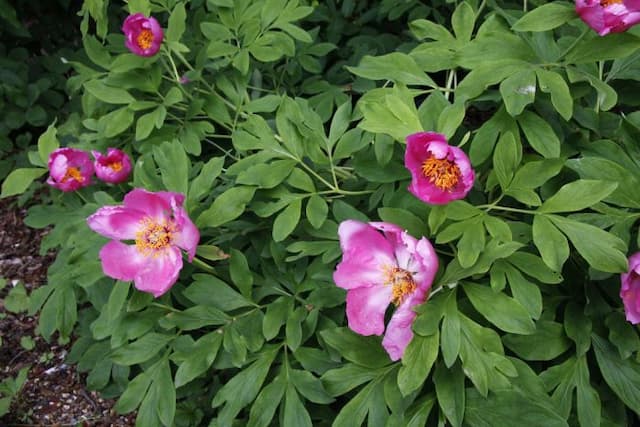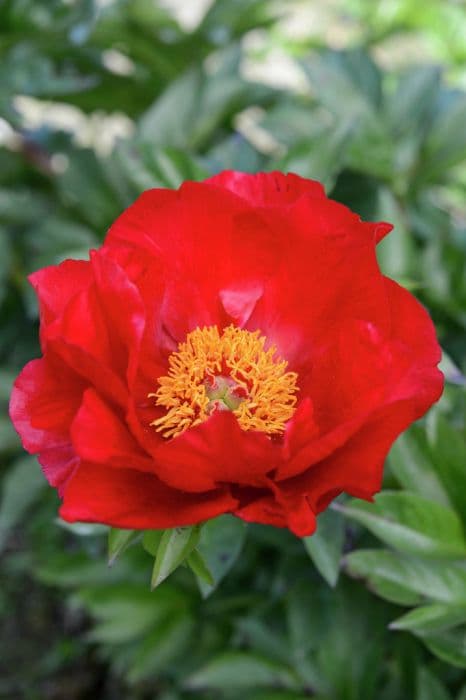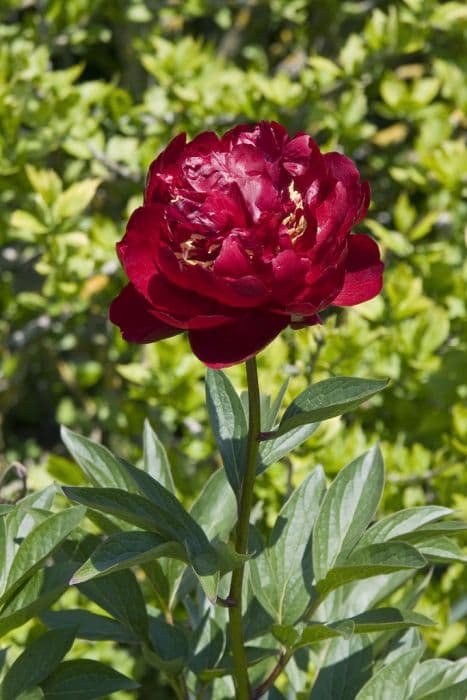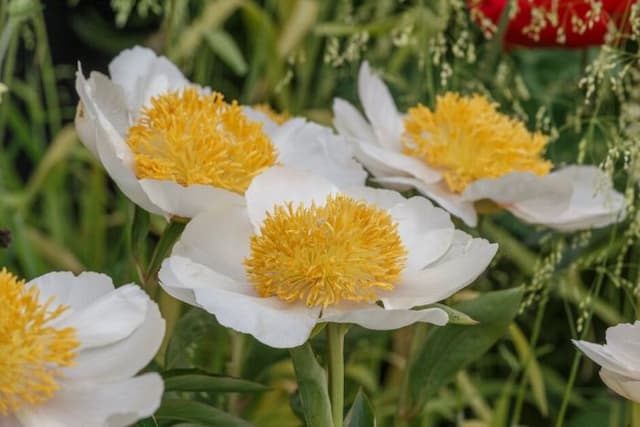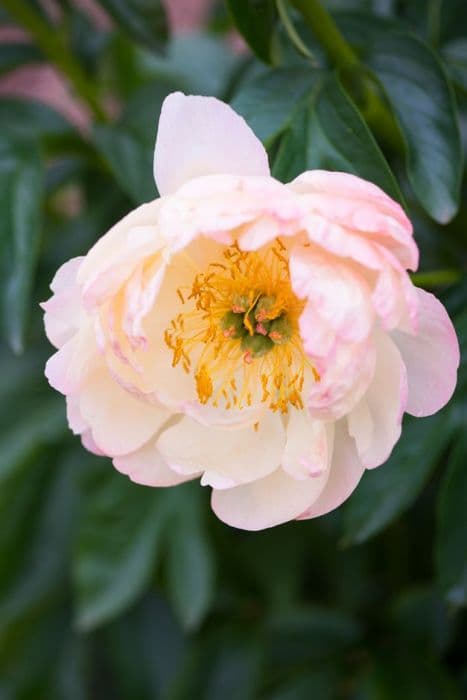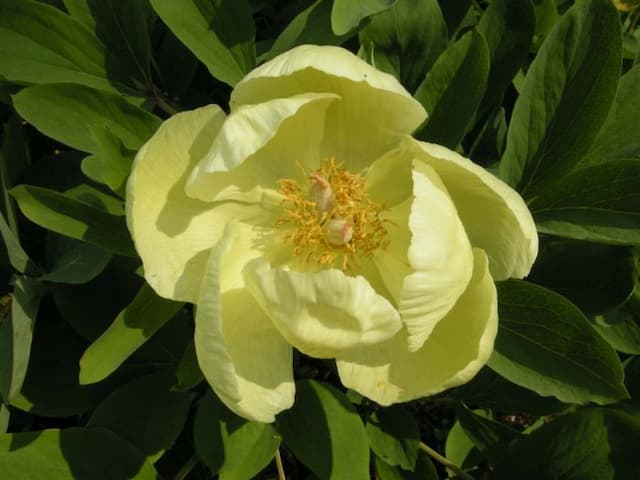Peony 'Garden Treasure' Paeonia 'Garden Treasure'

ABOUT
'Garden Treasure' is a hybrid between a tree peony and a herbaceous peony forming a plant about 65cm high and up to 1.5m across with a woody base. It has deeply-divided, dark green leaves and large semi-double to double, lemon-yellow flowers, over a four to six week period from late spring
About this plant
 Names
NamesFamily
Paeoniaceae.
Synonyms
Garden Treasure Peony, Garden Treasure Itoh Peony.
Common names
Paeonia 'Garden Treasure'.
 Characteristics
CharacteristicsLife cycle
Perennials
Foliage type
Deciduous
Color of leaves
Green
Flower color
Yellow
Height
2 feet 60 cm
Spread
3 feet 90 cm
Plant type
Herbaceous
Hardiness zones
4
Native area
Asia
Benefits
 General Benefits
General Benefits- Attracts Pollinators: 'Garden Treasure' peony attracts beneficial insects like bees and butterflies, promoting pollination in the garden.
- Long Bloom Period: This variety typically has a longer flowering period than other peonies, offering extended visual appeal.
- Herbaceous Perennial: As a perennial, it returns year after year, saving the gardener time and money on replanting.
- Striking Flowers: The peony features large, vibrant yellow flowers that can be a focal point in any garden design.
- Fragrance: 'Garden Treasure' peony emits a pleasant scent that can enhance the sensory experience of a garden.
- Drought Tolerance: Once established, it is relatively drought-tolerant, requiring less watering and maintenance.
- Low Maintenance: Peonies in general are known for being low-maintenance, which makes them ideal for both novice and experienced gardeners.
- Deer Resistance: This plant is often resistant to deer, which helps to prevent damage and the need for additional protective measures.
- Cut Flowers: The blooms make excellent cut flowers, lasting long in vases and adding beauty to indoor spaces.
 Medical Properties
Medical PropertiesThis plant is not used for medical purposes.
 Air-purifying Qualities
Air-purifying QualitiesThis plant is not specifically known for air purifying qualities.
 Other Uses
Other Uses- Peony petals can be added to salads or desserts for a gourmet touch, with a light, sweet flavor and a splash of color.
- Dried peony petals can be used in potpourri blends for a pleasant fragrance in your home.
- The peony 'Garden Treasure' can be used as a natural dye, where the petals provide subtle hues to fabrics or paper.
- These plants can be used in floral crafts, such as making peony petal confetti for celebrations or weddings.
- Pressed peony flowers can create beautiful natural art, suitable for framing and decoration.
- Peony flowers are used in perfumery, as they can contribute to complex floral scents in high-end fragrances.
- They can also serve as inspiration for artists and photographers as their vibrant and lush blooms make for exquisite subjects.
- Peony blossoms can be frozen in ice cubes to create an ornamental and refreshing addition to summer drinks.
- Planted peonies can be used as natural borders or living fences in gardens, adding privacy as well as aesthetic appeal.
- Blooms of the peony 'Garden Treasure' can be used in bathwater for a luxurious, calming soak with light fragrance.
Interesting Facts
 Feng Shui
Feng ShuiThe Peony is often used in Feng Shui to promote love and romance, and enhance prosperity. It's best placed in the southwest corner of the garden or home, as this is considered the area associated with love and marriage. The lush blooms of the Peony can also symbolize wealth and honor in Feng Shui, making them a beneficial addition to areas connected to financial prosperity.
 Zodiac Sign Compitability
Zodiac Sign CompitabilityThe Peony is not used in astrology practice.
 Plant Symbolism
Plant Symbolism- Romance: The peony, often referred to as the king of flowers, is widely regarded as a symbol of romance and is commonly associated with the 12th wedding anniversary, representing a happy marriage.
- Prosperity: In many cultures, peonies are believed to bring good luck and fortune, making them a popular plant during festive occasions or when starting a new venture.
- Beauty: With its full, rounded blooms, the peony is considered a symbol of beauty in all forms, hence often featured in artistic works and gardens.
- Honor: In some societies, the peony embodies honor and high value, as well as respect and recognition for achievements.
- Wealth: Alongside prosperity, peonies are also believed to attract wealth and are commonly used in Feng Shui practices to invite financial abundance.
- Good Fortune: Peonies are considered a good omen, bringing positivity and good fortune to those who grow or receive them.
- Compassion: The lush, soft petals of peonies can symbolize compassion and a gentle, caring nature, expressing empathy towards others.
- Bashfulness: Because of the way peony buds are seen to slowly open, they can also represent bashfulness or shyness in some cultural contexts.
 Water
WaterGarden Treasures Peony should be watered deeply once a week, providing about one inch of water, which equates to roughly 0.623 gallons for a square foot. During hot and dry periods, the frequency may need to increase to twice per week. Water at the base of the plant to keep the foliage dry and prevent fungal diseases. It's important not to overwater, as peonies do not like to sit in wet soil. Ensure the soil drains well and adjust watering based on rainfall, as the plant can withstand short periods of drought.
 Light
LightGarden Treasures Peony thrives in full sun, meaning at least six hours of direct sunlight daily. The ideal spot for this peony would be in a garden location that receives morning sun and partial afternoon shade, especially in hotter climates to prevent scorching. Avoid deep shade areas, as insufficient light can reduce blooming and weaken the plant.
 Temperature
TemperatureGarden Treasures Peony prefers temperate climates and is hardy in USDA zones 3 to 8. The plant can survive a winter minimum temperature of -40 degrees Fahrenheit and a summer maximum temperature of 85 degrees Fahrenheit. However, the ideal growing temperature for this peony is between 65 and 75 degrees Fahrenheit.
 Pruning
PruningPrune Garden Treasures Peony after it blooms, typically in late spring or early summer, to remove spent flower heads and encourage healthy growth. Peonies generally require minimal pruning, but removing dead or weak stems can improve air circulation. In the fall, cut back the foliage to the ground after the first frost to prepare for winter and reduce the risk of disease.
 Cleaning
CleaningAs needed
 Soil
SoilGarden peonies thrive in well-draining, fertile, loamy soil with a neutral to slightly alkaline pH between 6.5 to 7.5. A mix containing two parts garden soil, one part compost, and one part perlite or coarse sand is ideal to promote good root health.
 Repotting
RepottingPeonies, such as 'Garden Treasure', are long-lived perennials and do not need to be repotted regularly. They can remain in the same location for many years as long as the soil remains fertile and well-drained.
 Humidity & Misting
Humidity & MistingGarden peonies do not require high humidity and are tolerant of the typical humidity levels found in most temperate climates. They thrive outdoors where the humidity fluctuates naturally.
 Suitable locations
Suitable locationsIndoor
Not ideal for indoor growth; needs sun, planting in fall.
Outdoor
Plant in sun, well-drained soil; fall is best.
Hardiness zone
3-8 USDA
 Life cycle
Life cycleThe life cycle of Paeonia 'Garden Treasure', commonly known as the Garden Treasure Peony, begins with seed germination, typically in late winter or early spring, when the soil begins to warm. Once the seeds germinate, the plant develops a root system and shoots that emerge above the soil, forming the first true leaves. Over the years, the peony will develop into a bushy perennial plant with compound, deeply lobed leaves and sturdy stems. Each spring, the plant enters a rapid growth phase, culminating in the production of large, fragrant, yellow flowers that bloom in late spring or early summer. After flowering, the peony sets seed in the form of seed pods, which, upon maturity, release seeds to complete the cycle. During the fall and winter, the above-ground parts of the plant die back, and the peony enters a period of dormancy, relying on its extensive root system to survive the cold months until the cycle begins anew with the next warm season.
 Propogation
PropogationPropogation time
Spring-Early Summer
Propogation: The common name for Paeonia 'Garden Treasure' is the Garden Treasure Peony, and its propagation is most successfully done by division. The ideal time to propagate peonies by division is in the fall, when the plants have died back and are dormant—usually late September to October. To propagate by division, one should carefully dig up the peony plant, ensuring a large amount of roots are intact. The roots, or tubers, should then be divided into sections ensuring that each division has at least three to five eyes, which are the potential growth points for new shoots. These sections can then be replanted in well-prepared and well-draining soil with the eyes positioned around 1 to 2 inches below the surface of the soil, which equates to approximately 2.5 to 5 centimeters. It is important to provide adequate water for the new divisions but to also avoid overwatering which could lead to rot. Careful handling during the division process and proper planting can lead to successful propagation and new peony plants for the garden.
